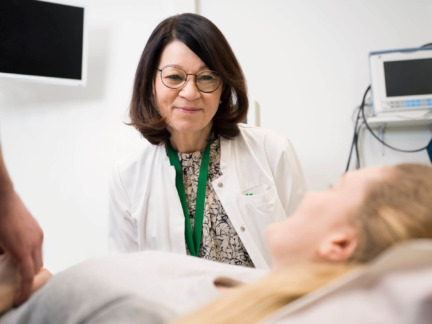Microfertilisation (intracytoplasmic sperm injection, ICSI)
In some cases, in vitro fertilisation is carried out as a microfertilisation (microinjection) procedure.
Microfertilisation (ICSI)
Microinjection (intracytoplasmic sperm injection, ICSI) is an important treatment method for infertility if the quality of sperm causes issues. The method has been in use since the early 1990s and the outcomes of pregnancy correspond to the outcomes of traditional IVF treatment. The first ICSI child in Finland was born in 1991 as a result of Felicitas’s treatment.
What happens during ICSI treatment?
Ovarian follicles are grown and matured and eggs are retrieved as in conventional IVF treatment for the purpose of ICSI treatment. In microfertilisation, the egg is fertilised by inserting a single sperm with a thin glass needle into the egg with the help of micromanipulator equipment. With the procedure, our experienced laboratory specialists ensure that the sperm enters the egg cell, even if it cannot move, stick to the surface of the egg cell or penetrate the shell of the egg cell itself. This allows us to support fertilisation if the quality of the semen is not good enough for conventional in vitro fertilisation.
The semen sample is prepared for fertilisation before microinjection. The purpose of sample processing, i.e. washing, is to separate the best quality sperm from the semen. After washing, the sperm are examined under a microscope and the sperm with the best motility and structure are selected for fertilisation. Fertilisation is carried out in the afternoon of the egg retrieval day.
In microinjection treatment, normally 70–100% of egg cells are fertilised. In order to maintain good results, we at Felicitas Mehiläinen continuously monitor the outcomes of fertilisation in our laboratories with international indicators as a benchmark, consequently ensuring the high quality of care.
ICSI therapy is discretionarily used if:
- the quality of the semen is poor in a sperm analysis or the treatment day sample
- the sperm count after washing is not sufficient for in vitro fertilisation treatment IVF)
- the outcome of fertilisation has been poor in previous treatments
- there is a long history of unexplained infertility
- the eggs used for fertilisation are cryopreserved or
- the man has been sterilised (testicular biopsy ICSI).
Progress of ICSI treatment
- First appointment with an infertility specialist and infertility examinations
- Treatment planning and consent
- Ovarian follicle stimulation
- Egg retrieval and sperm collection
- ICSI with the selected technique on the day of egg retrieval
- Embryo culture in a laboratory
- Embryo transfer and/or cryopreservation for later use
Modified ICSI methods
Different ICSI techniques for different situations have been developed with an aim of ensuring the fertilisation and embryonic development of eggs even in the most challenging cases. We always carefully choose the best form of treatment suited to your individual situation.
Testicular biopsy ICSI
If no sperm (azoospermia) are found in the man’s semen sample but they are still present in the testicular tissue, sperm can be collected directly from the epididymides or testes (testicular biopsy). Testicular biopsy sperm can be used in fertilisation with the microinjection technique. Sperm collection from the testis can be done on the day of the egg retrieval procedure, when fresh sperm is used for fertilisation or the tissue sample may be cryopreserved and thawed.
LAISS
The LAISS (Laser-Assisted Immotile Sperm Selection) method can be used to distinguish live, fertile sperm from immotile sperm. The LAISS method is useful when sperm are found in the semen, but they are immotile (asthenozoospermia or necrozoospermia) or if sperm extracted from testicular tissue is used in treatment. In the LAISS procedure, a laser pulse to which live sperm react differently than immotile sperm is targeted at the tail of the sperm. The fertility of live sperm cells is significantly better than that of the immotile, partially dead sperm.
PICSI
The PICSI (physiological ICSI) method is intended to support the selection of sperm in microinjection therapy. The PICSI procedure is based on separating mature sperm from the semen. Mature sperm cells produce a specific molecule (hyaluronic acid, HA) on their surface, which normally binds them to the cell zone around the egg. The binding capacity of sperm is tested with PICSI and the most fertile, mature sperm are selected for use in microfertilisation.
PICSI treatment may be considered if:
- sperm DNA fragmentation has been verified or the result of a sperm morphology analysis is abnormal (teratozoospermia)
- IVF treatment results in poor fertilisation outcomes even if the sperm analysis result is normal or there are poor fertilisation outcomes with ICSI or
- embryo development has stopped before the blastocyst phase, previous treatments are repeatedly ineffective or there are recurrent miscarriages in the medical history.
What if ICSI does not help?
In very rare cases, the egg cannot be fertilised even with microinjection. In this case, we can use egg stimulation to support fertilisation.



